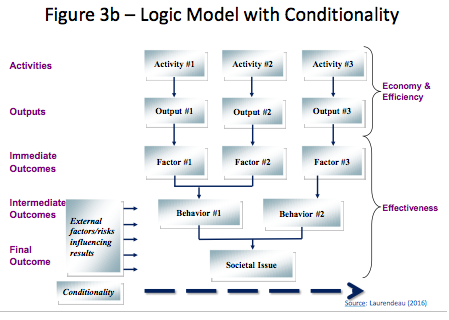Hello, my name is Michel Laurendeau, and I am a consultant wishing to share over 40 years of experience in policy development, performance measurement and evaluation of public programs. This is the third of seven (7) consecutive AEA365 posts discussing a stepwise approach to integrating performance measurement and evaluation strategies in order to more effectively support results-based management (RBM). In all post discussions, ‘program’ is meant to comprise government policies as well as broader initiatives involving multiple organizations.
This post articulates how logic models should be structured when program designs include multiple strategic elements (or program activities) supporting a common objective.
Step 3 – Addressing Conditionality
Program interventions rarely rely on a single product or service to achieve intended results. In fact, program strategies are most often designed using multiple interventions from one or more players. In these situations, there normally exists some conditionality between separate program activities as they support and interact with each other. Addressed this way, the notion of conditions (also used in the TOC literature) allows structuring logic models by properly sequencing the multiple program interventions (i.e. converging results chains) deemed to contribute to a common final result that is specific to the program.
To an outside observer being exposed to multiple interventions, program activities may appear to be delivered in a sequential manner (from left to right) based on some observable results (e.g., outputs or immediate outcomes) until some final outcome is achieved (see Figure 3a). This would be the case of a person arriving at a hospital emergency or an employment centre and being subjected to a series of treatments or services.
However, from a program perspective, all activities are actually implemented in parallel with different clients and/or players. In the examples of the hospital emergency and the employment centre, it is the clients who are moving from left to right across activities as they are exposed to various program services. In programs that reach clients only indirectly (e.g., environmental programs or economic policies), it is rather the projects or client files that are shifting across activities while being processed and/or subjected to various program interventions.
Conditionality then allows taking into account the relationships between the strategic elements (or activities) of program interventions without the need to clutter the logic model with an exhaustive mapping and display of all possible interactions and feedback processes. Implicitly, all program activities are (or may be) influenced to some extent by previous activities situated at the left of the diagram (see Figure 3b). Thus, when conditionality exists and is properly taken into consideration, the positioning of program activities in the logic model becomes important for the description and understanding of the program theory of intervention (PTI).
The next AEA365 post will dwell further into program implementation and discuss how to best integrate delivery processes into logic models in order to effectively support management oversight and control.
Do you have questions, concerns, kudos, or content to extend this aea365 contribution? Please add them in the comments section for this post on the aea365 webpage so that we may enrich our community of practice. Would you like to submit an aea365 Tip? Please send a note of interest to aea365@eval.org . aea365 is sponsored by the American Evaluation Association and provides a Tip-a-Day by and for evaluators.


